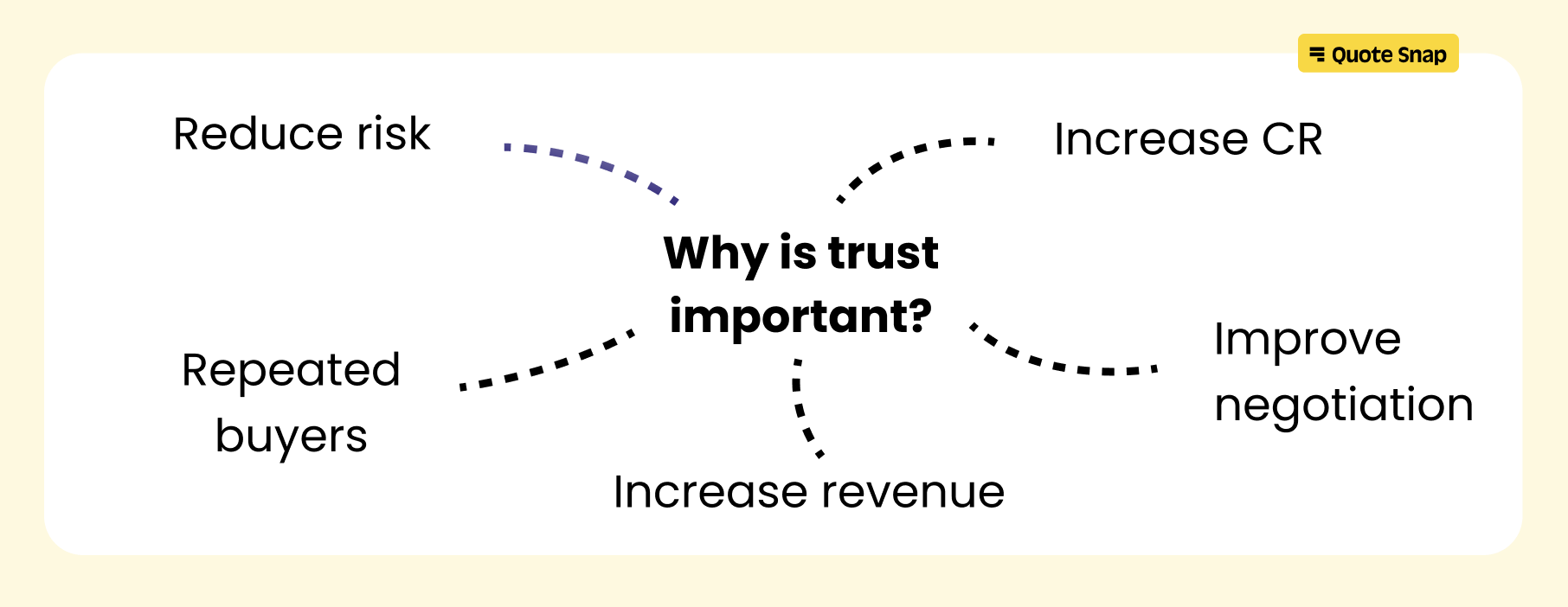How to create a successful Request for Quote? Let's find out the 2 easy steps to success through this blog.
|
Table of contents 3. How to Build Trust and Professionalism with RFQs 3.1. Understanding the process of Request for Quote 3.2. Where's the space for professionalism and trust-building? |
Businesses that have complicated pricing models or offer customized products and services greatly benefit from using Request for Quotation (RFQ). It is a document asking the store owners to tell you how much they would charge for something you want to buy, so you can decide where to get the best deal. Whether you're an established online retailer, a budding startup, or an ambitious entrepreneur, mastering the art of creating a successful RFQ is crucial to your success.
In this blog, we will explore the two key factors that can make all the difference in your RFQ journey: trust and professionalism.
Key factor #1: Trust
E-commerce is a high-risk landscape. To make a buying decision, customers need to carefully consider many factors. Consequently, as an e-commerce seller, establishing trust becomes crucial. For businesses that deal with custom products or services that have no fixed pricing, this is even more important. Because customers might feel confused and not safe if the price is unclear. With businesses that have the above traits, the Request for Quote (RFQ) process is a critical stage in the customer journey where trust can be fostered.
Why is trust important?
Imagine you as a customer, browsing the website to find a gift for your lovely mom for her birthday. You already have what you want to buy in mind, but now the problem arises, the website selling it looks unsafe. The product has no review, and the price is hidden. Will you buy it confidently without any fear of getting scammed? I doubt that.
You should not ignore the importance of trust in your eCommerce business. Why? Because:
- Trust increases the conversion rate: Trustworthy e-commerce businesses are more likely to convert RFQs into actual sales. The more sales you make, the more revenue you get.
- Trust reduces risk: Businesses that use RFQs often deal with complex, high-value transactions. Trust reduces the perception of risk for both parties, making customers more comfortable with making larger purchases.
- Trust creates repeated buyers: Satisfied customers are more likely to return for repeat purchases.
- Trust improves negotiation: Trust can facilitate smoother negotiations during the RFQ process. When both parties trust each other, they are more willing to collaborate, leading to mutually beneficial agreements.
- Trust creates better relationships with Suppliers: Trust is not limited to customers; it also extends to your suppliers. Suppliers are more likely to offer favorable terms and pricing when you have a reputation for reliability. This can lead to cost savings and improved product availability.
- Trust makes business growth: Ultimately, trust can lead to business growth. Satisfied customers, positive reviews, and strong relationships can attract more customers and opportunities, leading to expansion and increased revenue.
Key factor #2: Professionalism
Imagine you need a laptop on a tight budget. You find a website selling it but hiding prices, so quote requests are necessary. The process was unprofessional, and filled with errors and delays. Buying a whole new laptop is a big decision that needs to be carefully considered. Will you easily choose to spend such a big amount of money on a firm that lacks professionalism? That’s why professionalism is important in building trust!
How to Build Trust and Professionalism with RFQs
1. Understanding the process of Request for Quote:
John, a potential customer, found your website. He wants to have a customized pen to give his beloved mom. Then, John filled out a quote form. He shared his dream pen's details, budget, and timeframe. Your team carefully reviewed his request and created a customized quote with different pricing options. Excitedly, you sent the quote to John via email. You continued to communicate through email, answering his questions and finding common ground. Together, you embarked on a journey to create his perfect pen.
Through John’s story, we can tell the typical RFQ process involves several key steps:
- Get quote details: Customer fills out a quote form on your website. This provides their requirements, budget, timeframe, and contact details.
- Prepare & send quote: The RFQ is reviewed, and a customized product/service quote with pricing options is emailed to the customer for their review and potential acceptance.
- Follow-up: Communications continue between the customer and sales rep via email to finalize any questions and reach an agreement.
2. Where's the space for professionalism and trust-building?
At every step, there is a great chance to demonstrate the professionalism of your business and gain trust. Our aim is to provide thorough guidance through this blog, so let's explore together how to make the most of each small step.
Step 1: Get Quote details
The first meeting is crucial for making a good impression. If John can't figure out how to tell you what he needs, he might quickly lose interest. Typically, you can place contact information where it's easy to find, so customers can reach out to you. However, customers will appreciate it if you make the process more straightforward. Using advanced methods not only makes it more convenient for customers to send you a quote but also makes it easier for you to handle all the requests. And after all, a more professional image will be created in your customer’s mind.
So what are the advanced ways that we are talking about?
- Request a Quote Button: Add a "Request a Quote" button on product pages for quick access to a quote request form.
- Dynamic Pricing Tool: Use a tool that shows real-time price changes as customers choose options, allowing them to request a quote based on their preferences.
- Built-in form: Include short customizable quote request forms directly on product/category pages for one-click convenience.
- Chatbots and AI Assistants: Deploy chatbots or AI assistants, including an AI search engine, to provide guidance and gather information on customer quote inquiries.
Step 2: Prepare & Send Quote
Now that you know what John needs, your duty is to review the Request or quote (RFQ) and prepare the customized pen that John asked for. Then, offer him the During this process, by going above and beyond the basics, this is a great opportunity to showcase your business's professionalism.
- Timeliness: Once you receive the RFQ, quickly let the customer know you got it and that you're checking it. If you have any questions about it, ask right away. Sending an instant confirmation message after form submission is crucial. To automate this task, use a tool that automatically sends confirmation emails to customers. This eliminates the need for manual email sending and the constant monitoring of your inbox for new requests.
- Attention to Detail: Even a tiny mistake, like getting the quantity or customer name wrong or making a typo, can make your business seem unprofessional.
- Customization: Make sure to offer your customer a high level of service by providing personalized options or solutions to their demand.
- Presentation: Presenting the quote in a visually appealing and well-organized format showcases professionalism. Using a consistent and branded template, including the company logo. If you use an application for this quoting process, there are many templates for you to choose from.
Step 3: Follow-up communication
Throughout the RFQ process, John has already shown a strong commitment to you. Now, it comes to the stage where you and John talk together to reach a consensus. However, it's important not to lose your focus at this point. During this process, you are closer to the end point of having the final deal and getting the revenue. By maintaining a professional approach, you can secure an enticing offer and potentially gain a loyal customer. Now, in this final stage, what should a professional business do?
- Flexibility & Problem-solving: Be open to your customer’s specific requests or modifications to the quote. With any challenges, approach with a problem-solving mindset.
- Written communications: Ensure proper grammar, spelling, and punctuation. Avoid slang and informal language. Maintain a well-structured, easy-to-read email. Address the customer respectfully and professionally.
- Be transparent: Once you have reached an agreement, be sure to put it in writing. This will help to avoid any misunderstandings down the road.
The bottom line
A successful Request for Quote brings you the dream revenue and more potential loyal customers. To achieve that, trust and professionalism are absolutely the keys to opening the door to success. For businesses dealing with custom products and hidden pricing, earning your customers’ belief and showcasing your professionalism is even more important.
Maintaining a professional and trustworthy image is not easy. It requires experience, time, and effort. To make it simpler, you can use advanced tools like a user-friendly "Request a Quote" button and a quote management system. These tools simplify the process, help you pay attention to detail, and maintain transparent communication with your customers. One tool that can make your work easier while still being professional is Quote Snap - Request a Quote, Hide Price. If you're interested, you can request a demo or sign up now to see the amazing benefits for yourself. We guarantee you'll be pleased with the results!








